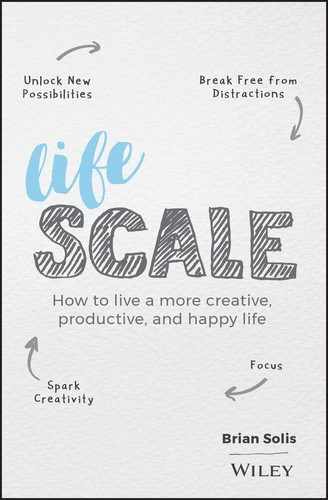CHAPTER 5
Rekindle
Creativity Is the Fountain of Youth, a Source of Innovation, and the Secret to Happiness

“You can't use up creativity.
The more you use, the more you have.”
– Maya Angelou
No matter how young or old we are, we can all rekindle our most youthful, unfettered, joyful creativity. Age and creativity are not bound to one another. Creativity is like an age-defying elixir.
The seemingly ageless actress Sophia Loren wisely said, “There is a fountain of youth: it is your mind, your talents, the creativity you bring to your life and the lives of people you love. When you learn to tap this source, you will truly have defeated age.”1 It keeps us young, sharp, optimistic, and enlightened.
“There is a fountain of youth: it is your mind, your talents, the creativity you bring to your life and the lives of people you love.”
Take the case of Gary Marcus, a cognitive psychologist at New York University, who had always wondered, what if he learned how to play a musical instrument when he was younger.2 Finally, one day, on the eve of his 40th birthday, he decided that he was going to learn to play the guitar. He began his immersion by playing Guitar Hero, a video game in which players match their rhythmic motions to the game's digital music sheet. In two years, practicing up to six hours per day, Marcus accelerated quickly through the awkward and struggling phases to experimenting, improvising, and composing his own music. His detailed experience was documented in his book, Guitar Zero: The Science of Becoming Musical at Any Age.
At the time of writing this chapter, I had orbited the sun 47 times. I hadn't realized how far away from the energizing heat of my youthful creative center I had traveled. I learned how to play the guitar when I was seven, played my first live show at 10, and wrote and recorded and toured with several albums worth of original material. I didn't appreciate fully at the time how special the thrill of playing was. As I wrote that line, I thought about the beautiful collection of guitars stuffed in a closet behind me that hadn't been able to sing because I hadn't made time for them. I stopped typing, walked into the closet, and stared at the guitar cases. I couldn't help but pull one out and start to play. Instantly, the musical passion I had repressed was rekindled.
We can all do this.
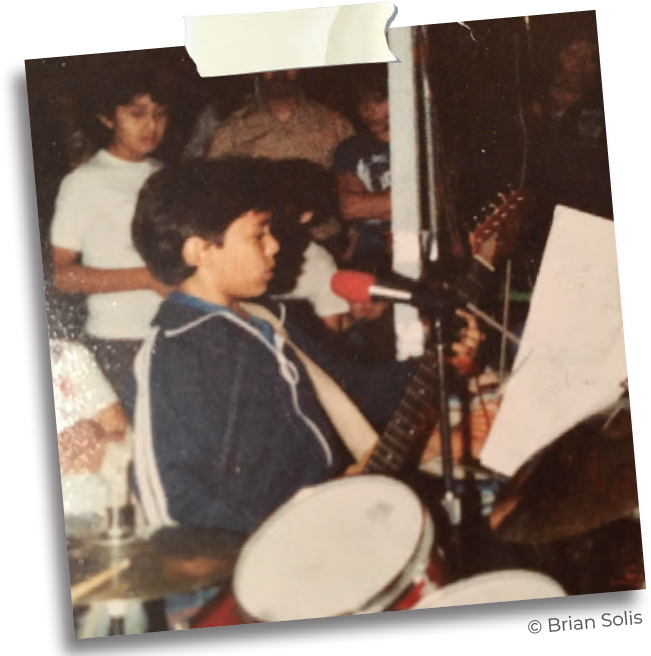
And we must, not only for the good of our performance at work, but for our happiness, and even for our health. In a study that examined the health benefits of creativity, Dr. Gene Cohen of George Washington University sought to understand how mental exercise is key to keeping the elderly young. “They want to be challenged, and science has shown that when you challenge older people, both physically and mentally, they do better,” Cohen explained in an interview.3 He also found that seniors who take on a creative challenge are healthier, they go to the doctor less, they are less depressed, and they suffer fewer injuries.
As life coach Triantafillia Memisakis writes,
As we grow up, some of us get scared out of being more creative. People judge us for it. So, we judge ourselves and censor our own creative expression. But, when we refuse to use our creativity . . . we suppress a very integral part of who we are. It's not just uncomfortable and unhelpful, when we suppress our creative impulses in this way, we can actually harm ourselves without even knowing it. Unused creativity warps into grief, rage, judgement, sorrow and shame. Not acknowledging or expressing our creative side can cause depression, uncertainty, stress and anxiety.4
On the flip side, the practice of creative tasks makes us happier. In a study published in 2016, psychologists found that spending time on creative goals is associated with a higher activated positive effect on that day and even the next.5 You're also more likely to continue creative pursuits the next day. Dr. Tamlin Conner, a psychologist at New Zealand's University of Otago and the study's lead author, explains “Engaging in creative behavior leads to increases in well-being the next day, and this increased well-being is likely to facilitate creative activity on the same day.” What's more, participants in the study also reported that they were “flourishing,” which researchers defined as experiencing positive personal growth. “This finding suggests a particular kind of upward spiral for well-being and creativity,” Dr. Conner noted. “Finding ways to encourage everyday creative activities, not just master works of art, could lead directly to increased well-being,” she concluded.6

It's time to reacquaint yourself with the artist formerly known as you. As my dear friend, entrepreneur, and on-air journalist Melissa Rowley once said, “You were born to create beautiful things because you were created from beauty. And, everything comes full circle.”
It's time to reacquaint yourself with the artist formerly known as you.
For some inspiration, let me share a brief story of one man who never lost touch with his inner child.
Conjuring a Magic Kingdom
Walt Disney not only said but demonstrated time and time again, “All our dreams can come true, if we have the courage to pursue them.”
I think like everyone, when I was young, I wanted to be older. Now I'm working to reconnect to my youth, which is just one of the many reasons I'm so humbled and inspired by Walt Disney. He once said, “That's the real trouble with the world, too many people grow up. They forget. They don't remember what it's like to be 12 years old. They patronize, they treat children as inferiors. Well I won't do that.”
“That's the real trouble with the world, too many people grow up.”

Disney dedicated himself tirelessly to enchanting and making us believe in magical worlds, and yet can you believe that in 1919, at age 18, Disney was fired from the Kansas City Star newspaper because his editor felt he “lacked imagination and had no good ideas”?7 Thankfully, Disney didn't believe him. Instead, he discovered ways to transform drawings and storybooks into immersive animated worlds rich with characters we all cherish. The most famous of them all, Mickey Mouse, was introduced to the world on November 18, 1928,8 when Disney was 27 years old. And, here we are today, still crazy about Mickey.
But Disney was by no means simply born with overflowing talent. He was as much a hard worker as an artist. He believed in highly disciplined goal setting, saying, “A person should set his goals as early as he can and devote all his energy and talent to getting there. With enough effort, he may achieve it. Or he may find something that is even more rewarding. But in the end, no matter what the outcome, he will know he has been alive.”
“All you've got to do is own up to your ignorance honestly,” he said, “and you'll find people who are eager to fill your head with information.”
Disney had to overcome many obstacles. Receiving only an eighth-grade education, he chased after whatever he needed to know to pursue his dreams. He never stopped learning. He sought apprenticeships, taught himself animation, and invented new technologies, systems, and processes to bring his ideas to life until the day of his passing. “All you've got to do is own up to your ignorance honestly,” he said, “and you'll find people who are eager to fill your head with information.”
Throughout his life's work he faced naysayers who told him, “It cannot be done,” and he suffered many setbacks. His first animation company, Laugh-O-Gram Films, went bankrupt in 1921. At age 21, he left Kansas City for Southern California with $40 to his name. After arriving in Los Angeles, he sought work as a director of live action films in the silent film industry, but no one wanted to hire him.
So, instead he founded Disney Bros. Studio in Hollywood, along with his brother Roy. After developing the character of Mickey Mouse, then named Mortimer,9 Disney made two animated shorts featuring him, Plane Crazy and The Gallopin' Gaucho, but failed to secure distribution for them. He moved right on to creating another Mickey film, the innovative Steamboat Willie, which brought sound to animation. That finally scored a distributor, and soon, Mickey Mouse surpassed Felix the Cat to become the world's most popular cartoon character.

Later in life, Disney expressed gratitude for his failures and challenges. “All the adversity I've had in my life, all my troubles and obstacles, have strengthened me. . . . You may not realize it when it happens, but a kick in the teeth may be the best thing in the world for you.”
In How to Be Like Walt, by Pat Williams with Jim Denney, Roy Disney shared his brother's secret to success: “If Walt had one great gift, it was that he kept his head down and kept trying. Over the years, he was told that his ideas were impractical, impossible and would never work. Walt proved the only way to get things done is by sticking to your ideas and your beliefs.”
Rather than resting on his achievements, he kept pushing himself into new territory, his projects becoming ever more ambitious. Despite so many successes, he still faced doubters, including his brother Roy and wife Lillian. In 1934, he set out to produce his first feature-length animated film, Snow White and the Seven Dwarfs. The project was a big risk. The initial budget for the film was $250,000, which was 10 times that of the company's average Silly Symphony short. Justifiably frightened, Roy and Lillian attempted to dissuade Walt, but he paid no heed, mortgaging his house to help finance the production. As production costs skyrocketed to almost $1.5 million, an astronomical sum during the Great Depression, he kept his nerve—with good reason. The initial run of Snow White earned roughly $8 million, equivalent to about $134 million in today's terms.
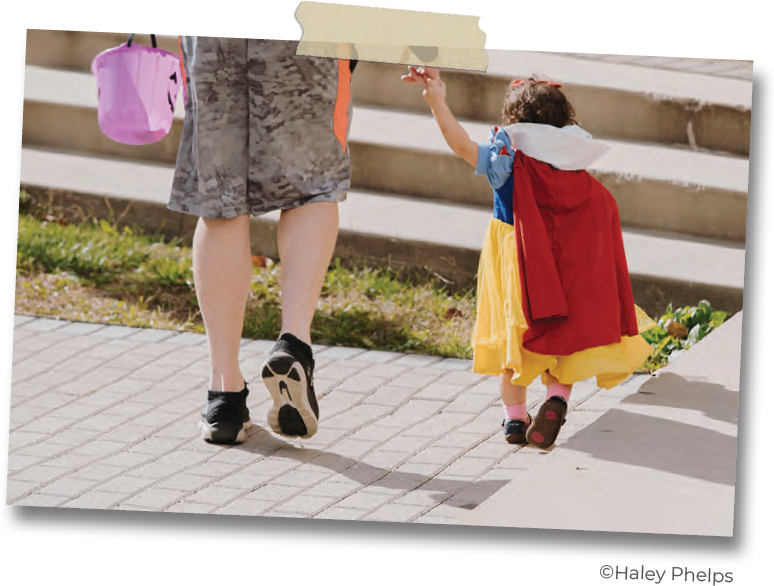
If the tools he needed for realizing his vision weren't available, he created them. He invented to pave the way for his other inventions. Disney's lists of firsts10 and inventions11 is practically countless, including the opening of the landmark Disneyland and Disney World, development of audio animatronics (electro-mechanical robots), the creation of People Movers and Monorails, the introduction of the world's first indoor shopping mall, the debut of switch-back and interactive lines, building fully enclosed attractions, many developments in ride innovation, and the creation of life-size models for cities of the future.
Disney referred to his creative process as imagineering, combining imagination with engineering.12 He made magic by mixing imagination and determination. He captured the little hearts and big imaginations of children. He also helped former kids rekindle the magic of their youth. And now, we pass the magic of his creative kingdom onto our children, so that future generations too can hold on to heart, imagination, and invention. And as big kids looking to stay young, happy, and creative, we have to hold on to those dreams, and mix imagination and determination in our own life and work. That's the Disney ethic—stay true, stay dedicated. As he said, “The difference in winning and losing is most often not quitting.”
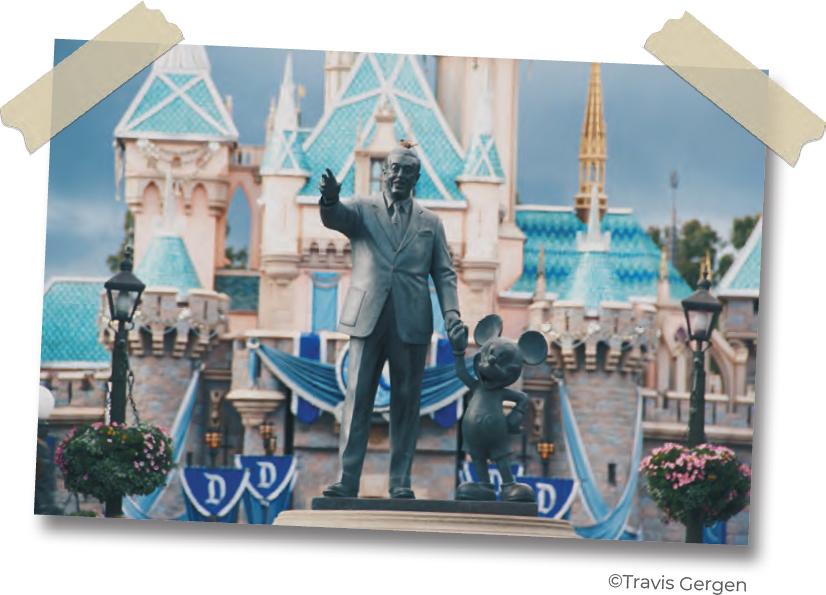
As we seek to reignite our creativity, we should prepare for some pain. Exercising our creativity unleashes happiness, but that doesn't mean it's always bliss. We'll almost surely encounter our own naysayers. The value of ideas is a matter of perspective. They are judged through the lenses of entrenched mindsets and cognitive biases. The way we think about our ideas and the way they're heard are often not in alignment, and expression of them pushes the boundaries of comfort for many of those in our lives. They may roll their eyes when we haul out our guitars or sit down to finally write that novel. It's an unfortunate reflex for many to belittle the creative endeavors of others, even of loved ones. It's okay. It's not you.
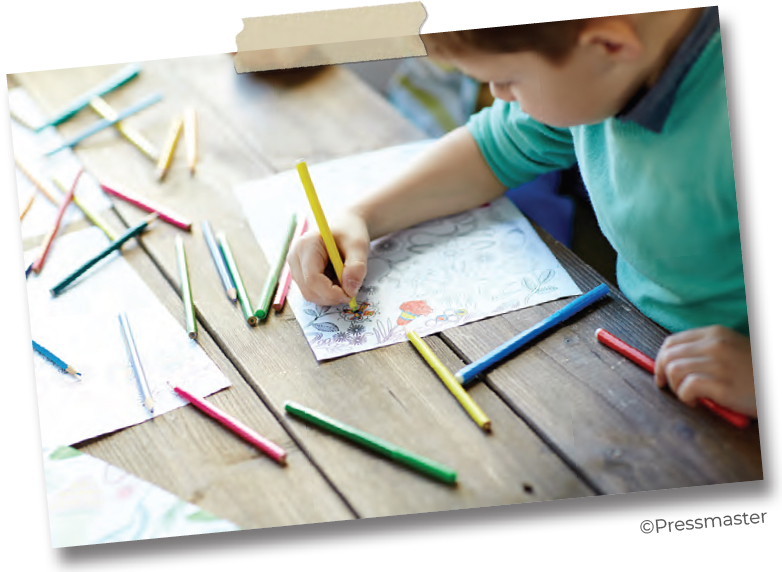
I find it helpful when I'm feeling the naysaying grownup Brian sneak up on me, telling me to stop pretending I'm creative, worrying about what the critics will say, to think of Walt Disney's 22 Academy Awards and seven Emmys. In 1964, he received the Presidential Medal of Freedom. But he still didn't believe in resting on his laurels. “Around here,” he said of the thriving company he created, “we don't look backwards for very long. We keep moving forward, opening up new doors and doing new things, because we're curious . . . and curiosity keeps leading us down new paths.”
“We don't look backwards for very long. We keep moving forward, opening up new doors and doing new things, because we're curious . . . and curiosity keeps leading us down new paths.”
 As I've worked on this section about him, I've realized I want to be an imagineer when I grow up, or I should say, when I grow young again. What do you want to be?
As I've worked on this section about him, I've realized I want to be an imagineer when I grow up, or I should say, when I grow young again. What do you want to be?
Color Outside the Lines Again: Get Back to the Roots of Your Creativity
Right now, go and find a Flux Capacitor, get in your DeLorean, hit 88 miles per hour and go back to a time when you were alive with overflowing creativity, ideas, aspirations and didn't like following the rules or being told what to do. Start a revolution within yourself.
(If you have no idea what a Flux Capcitator is and only a vague sense that I'm taking a nod from the movie Back to the Future, immediately put the film on your watch list.)
Remember when you were young. What did you enjoy doing as a child? What do you wish you could always have done but never did?
 Start asking questions. Part of following the rules is to not question them. But if you remember, one of your favorite questions to ask was, “Why?” We were curious. We honestly wanted to know why something existed, why we did things certain ways, why people were the way they were, why we couldn't do something, and so on. Asking questions should be just as important to us as adults. We should challenge ourselves all the time with exploratory questions such as “What if . . .” or “How can we . . . ?” Let your curiosity run wild.
Start asking questions. Part of following the rules is to not question them. But if you remember, one of your favorite questions to ask was, “Why?” We were curious. We honestly wanted to know why something existed, why we did things certain ways, why people were the way they were, why we couldn't do something, and so on. Asking questions should be just as important to us as adults. We should challenge ourselves all the time with exploratory questions such as “What if . . .” or “How can we . . . ?” Let your curiosity run wild.
 Let yourself be silly. Be a kid again and schedule playtime. Find time to do some of the things kids do. Play in a playground. Fly a kite. Build a sandcastle. Play tag or hide and seek. Watch cartoons and read children's books, even if you don't have children. Smile. Laugh. Take yourself to Disneyland!
Let yourself be silly. Be a kid again and schedule playtime. Find time to do some of the things kids do. Play in a playground. Fly a kite. Build a sandcastle. Play tag or hide and seek. Watch cartoons and read children's books, even if you don't have children. Smile. Laugh. Take yourself to Disneyland!
Who cares if you look weird? I don't. Nor should you.
 Shift positions from the impossible to seemingly possible. Banish the phrase we can't and investigate the possibilities that seem improbable.
Shift positions from the impossible to seemingly possible. Banish the phrase we can't and investigate the possibilities that seem improbable.
 List three ideas every day. Keep a running list of ideas you have each day, no matter how impossible, foolish, or grand. You don't have to stop at three. If ideas are flowing, bring them on. Visit the list every day as you add your new items and consider which of them you might now move to your actual to-do list.
List three ideas every day. Keep a running list of ideas you have each day, no matter how impossible, foolish, or grand. You don't have to stop at three. If ideas are flowing, bring them on. Visit the list every day as you add your new items and consider which of them you might now move to your actual to-do list.
 Find a creative project. You don't have to have talent in whatever you choose. Just find an outlet for exercising the right side of your brain. Paint, draw, doodle, write poetry or a book manuscript, script, or screenplay, play an instrument, cook, take pictures, make movies, or all of the above! Just create, regularly.
Find a creative project. You don't have to have talent in whatever you choose. Just find an outlet for exercising the right side of your brain. Paint, draw, doodle, write poetry or a book manuscript, script, or screenplay, play an instrument, cook, take pictures, make movies, or all of the above! Just create, regularly.
 Express yourself in all you do. Buy the clothes you love, stylish or not, pursue the activities that interest you, no matter how odd or boring they may seem to others; share your thoughts, even if they're contrarian or might seem wacky. Find your voice.
Express yourself in all you do. Buy the clothes you love, stylish or not, pursue the activities that interest you, no matter how odd or boring they may seem to others; share your thoughts, even if they're contrarian or might seem wacky. Find your voice.
 Be courageous. Fearing risk or failure is the cancer of creativity, and taking chances is rocket fuel. The more chances you take, the more you learn, gain experience, and build confidence, and that becomes contagious!
Be courageous. Fearing risk or failure is the cancer of creativity, and taking chances is rocket fuel. The more chances you take, the more you learn, gain experience, and build confidence, and that becomes contagious!
As you have fun finding ways each day to rekindle your creativity, please join me on the next steps of the journey of lifescaling—reconnecting with your hopes and dreams, rediscovering what truly makes you happy, and crafting a clear understanding of your life purpose, that is, your purpose for this phase in the ongoing process of lifescaling.
Notes
1https://people.com/celebrity/celebrate-sophia-lorens-80th-birthday-with-her-greatest-quotes/
2https://stateoftheart.creatubbles.com/2014/10/29/can-anyone-learn-to-be-creative/
3https://www.cbsnews.com/news/creativity-new-fountain-of-youth/
4https://www.happyandauthentic.com/the-secret-to-unlocking-suppressed-creativity/
5https://www.tandfonline.com/doi/abs/10.1080/17439760.2016.1257049
6https://www.huffingtonpost.com/entry/creativity-happiness-psychology_us_58419e0ce4b0c68e0480689a
7https://www.amazon.com/The-Wisdom-Oz-Accountability-Everything/dp/159184715X
8https://www.waltdisney.org/blog/birth-mouse
9https://www.learningliftoff.com/overcoming-obstacles-hard-work-and-persistence-paid-off-for-walt-disney/
10https://listverse.com/2013/05/31/10-amazing-but-overlooked-innovations-by-walt-disney/
11http://fortune.com/2014/12/29/disney-innovation-timeline/
12https://disneyimaginations.com/about-imaginations/about-imagineering/
